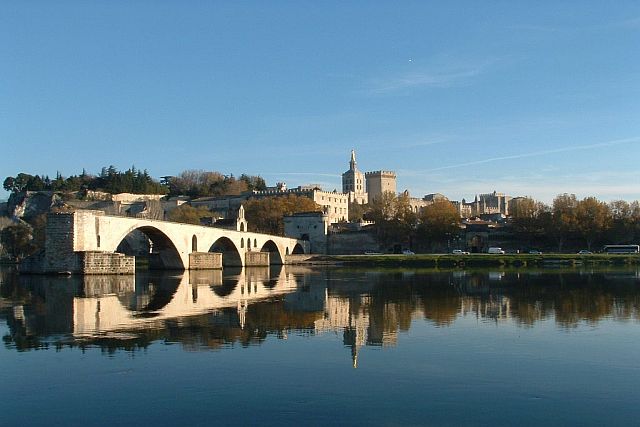 |
| Palace of the Popes was home to the Papacy for 70 years in Avignon, France (wikipedia) |
Today, thanks to the wonder of high speed rail
technology, Avignon is more accessible than ever
before, not only from France
 |
| High speed French TGV pulls into Avignon (wikipedia) |
Situated on the Rhone
River , just above its confluence with
the Durance, Avignon was founded by the Greeks
on an untamed promontory along the river route used by Greek, Marseille and
Italian sailors seeking trade with Northern Europe .
Thanks to the Rhone and its geographic location on
the primary route between Spain
and Italy , Avignon
It was another event however, that brought
prestige to Avignon which has lasted into modern
times and made it a thriving UNESCO World Heritage site as well as a popular
base for exploring Provence Rome to Avignon
The move altered Avignon
 |
| The Pont d'Avignon, Bridge of Avignon, only goes halfway across the River Rhone (wikipedia) |
Known as Altera Roma, the “City of the Popes,” Avignon
In 1377, Gregory XI decided to take the seat of
the Papacy back to Rome
 |
| Avignon's ultra-modern high speed rail station (wikipedia) |
Perhaps the most impressive aspect of the pope’s
tenure in central France Papal Palace
After the French Revolution, the palace became a
barracks and later, a prison before being renovated into its present
configuration as a museum.
Following Clement V, each successive pope added
his own personal imprint to the building making it one of the largest medieval
buildings in Europe . Today, the palace is
among the most visited attractions in France
The international festival for the performing arts
takes place annually in July incorporating the courtyard of the palace as an
immense open-air stage. Two other major events happen in conjunction with the
theater festival, one before and a jazz fest afterward, making Avignon
 |
| The facades of the Palace of the Popes dominate the Avignon skyline (wikipedia) |
The city is served by two railway stations; the
historic Gare d’Avignon-Centre, built in 1860, is situated just beyond the city
walls, and the modern high speed Gare d’Avignon TGV that is part of the
Mediterranean line connecting northern and southern France Spain ,
Italy , Switzerland and, thanks to the Channel Tunnel,
even England are convenient
destinations for visiting Avignon
Another popular sites in Avignon
is the Pont Saint-Benezet, also known as the Bridge of Avignon
Following a siege of the city, the bridge was
rebuilt with 22 stone arches that often collapsed during regular flooding of
the Rhone . Ultimately, further reconstruction
was abandoned in the 17th century, leaving the original bridge,
built in 1345 by Pope Clement VI, extending only partly across the river with
only just arches remaining.
 |
| Provence has long been a popular destination in France (wikipedia) |
One note of caution for visitors to Avignon , superb as the rail service to Avignon
Today, the ancient ramparts remain, giving Avignon a medieval flair as the entrance to one of the
most beautiful regions in France Provence
and, with excellent TGV rail services, a Paris/Provence vacation is an ideal
way to journey through France
Read more at: MagellanTravelClub.com
No comments:
Post a Comment